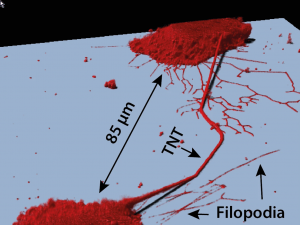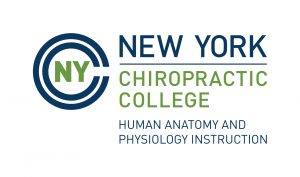 Pulse of Progress: Looking Back, Moving Forward | TAPP 147
Pulse of Progress: Looking Back, Moving Forward | TAPP 147
The A&P Professor
In Episode 147, host Kevin Patton reviews the highlights and events of the previous year in the world of The A&P Professor. He then turns to last year's predictions for teaching human anatomy and physiology to see if he was on the right track. Finally, predictions for the coming year are revealed. And lots of other stuff—this episode is two hours long, after all! 0:00:00 | Introduction 0:00:50 | Debrief: Topics, Stats, Reflections 0:21:28 | A Long, Long, Long Episode 0:23:05 | Debrief: More Reviewing & Reflecting 0:38:59 | Did I Get My Predictions Right? 0:50:22 | Textbook &...
info_outline Anatomy of Trust: Promoting Integrity in A&P Education | Winter Shorts | TAPP 146
Anatomy of Trust: Promoting Integrity in A&P Education | Winter Shorts | TAPP 146
The A&P Professor
Episode 146 of The A&P Professor podcast is one of our winter shorts, where I replay interesting segments from previous episodes. In this one, we discuss the importance of academic integrity in the Anatomy & Physiology course. We emphasize the need to incorporate discussions about integrity in the syllabus and course materials and share real-life examples of violations in the healthcare field. We highlight how dishonesty can have serious consequences and discuss strategies for prevention, such as using multiple test versions and unique topics for papers/projects. Providing examples of...
info_outline A Tongue Twister's Guide to Mastering Anatomy Pronunciation | Winter Shorts | TAPP 145
A Tongue Twister's Guide to Mastering Anatomy Pronunciation | Winter Shorts | TAPP 145
The A&P Professor
Episode 145 of The A&P Professor podcast is one of our winter shorts, where I replay interesting segments from previous episodes. In this one, you'll hear about the trials and tribulations of teaching and learning pronunciations of anatomy and physiology terminology. Including why the instructor is ALWAYS correct! 00:00 | Introduction 01:07 | Variations in Anatomy & Physiology Pronunciations 10:24 | Say Anatomy & Physiology Terms Out Loud 20:30 | Staying Connected ★ If you cannot see or activate the audio player, go to: 🏅 Apply for your credential (badge/certificate)...
info_outline Dissecting the Kenhub Atlas: Insights from Editor Mike Pascoe | TAPP 144
Dissecting the Kenhub Atlas: Insights from Editor Mike Pascoe | TAPP 144
The A&P Professor
Mike Pascoe joins host Kevin Patton in Episode 144 to chat about Mike's experience in editing the new Kenhub Atlas of Human Anatomy. We go behind the scenes to see how this new kind of anatomy atlas was developed. Let's see how those decisions get made and how the learning perspective gets incorporated into anatomy manuals. And we explore diverse representation in anatomy images and why we won't find any eponyms in this atlas. We also have a brief remembrance of our friend David Allard. 00:00 | Introduction 00:45 | Remembering David Allard 04:25 | Introducing Mike Pascoe 06:12 |...
info_outline The One Teaching Strategy That Will Fix Your Anatomy & Physiology Course | TAPP 143
The One Teaching Strategy That Will Fix Your Anatomy & Physiology Course | TAPP 143
The A&P Professor
In episode 143 of The A&P Professor podcast for anatomy and physiology faculty, host Kevin Patton uncovers the super-secret, single, ultimate teaching strategy you need to keep your course tuned up and effective. He also revisits the "out there" transducer model of the brain and suggests a connection with a recent discovery supporting quantum wave activity in brain cell microtubules. Yes, quantum waves in the microtubules. Kevin also clarifies and expands on those wacky "extra" courses he described in Episodes 140 and 141. 00:00 | Introduction 00:51 | Clarifying Kevin's Wacky Supplemental...
info_outline Muscle: A Gripping Story by Roy Meals | TAPP 142
Muscle: A Gripping Story by Roy Meals | TAPP 142
The A&P Professor
Get pumped up for Episode 142, where we have the honor of hosting Dr. Roy Meals, the musculoskeletal maestro! 💪 We're gonna flex our curiosity muscles and explore every nook and cranny of his latest masterpiece, Muscle: The Gripping Story of Strength and Movement. This episode's so dynamic, you might need a protein shake afterward! 0:00:00 | Introduction 0:01:13 | Re-Introducing Dr. Roy Meals 0:04:08 | Muscle Strain & Why We Train 0:13:53 | What Sword Swallowing Teaches Us About Muscle 0:24:49 | Muscle Stories: Learning Should Be Fun 0:38:48 | Staying Connected...
info_outline Study Courses Supercharge Anatomy & Physiology Success | TAPP 141
Study Courses Supercharge Anatomy & Physiology Success | TAPP 141
The A&P Professor
Get ready for a mind-bending 😲 rendezvous with Kevin Patton in Episode 141, where he continues to spill the beans on his top-secret recipe for student triumph. 🏆 Brace yourself for this next adventure on his whirlwind tour of revolutionizing A&P 1 education, as we dissect the art of identifying student pain points, personalizing preparation, and serving up the kind of mentorship they've been yearning for! 0:00:00 | Introduction 0:00:45 | One of Two Success Courses 0:09:48 | Setting Up the Supplement Course 0:18:44 | Structure of Class Sessions 0:40:17 |...
info_outline Pre-A&P: A Refresher for Student Success in Anatomy & Physiology | TAPP 140
Pre-A&P: A Refresher for Student Success in Anatomy & Physiology | TAPP 140
The A&P Professor
In episode 140, we introduce the development of the pre-A&P course and the A&P1 Supplement course. These courses address the challenges faced by A&P students and improve their readiness and comprehension. In this first of two episodes, we focus on the pre-A&P course. It focuses on filling subject knowledge gaps with 10 modules and cumulative tests. Student surveys and studies show its effectiveness in achieving higher grades in the A&P 1 course. Implementing these nontraditional courses requires collaboration and support from advisors and faculty members. Together, we...
info_outline Thinking New Thoughts about the Human Brain | TAPP 139
Thinking New Thoughts about the Human Brain | TAPP 139
The A&P Professor
In Episode 139, we explore a new discovery in nerve signaling in the brain called a dendritic action potential (dCaAP), we look at a whacky proposed model of brain function, and we share some ideas about how we can help our students understand the core concepts of chemical signaling and signal transduction in different contexts. Put on your thinking caps and jump into this fresh episode now. 00:00 | Introduction 00:50 | Dendritic Action Potentials 12:16 | Transducer Model of the Brain 21:43 | Chemical Signals & Signal Transduction 35:09 | Staying Connected ★ If you cannot see or...
info_outline Dancing Organelles, AI Resources, Distracting Animations, Timed Tests & Micro-credentials | TAPP 138
Dancing Organelles, AI Resources, Distracting Animations, Timed Tests & Micro-credentials | TAPP 138
The A&P Professor
In Episode 138 of The A&P Professor podcast for anatomy & physiology faculty, host Kevin Patton discusses some new thinking about organelle function, why decorative animations are not a good idea in our teaching slides, news about Wendy Riggs and the 2023 HAPS President's Medal, why I don't like timed tests, resources for AI in the curriculum, and why micro-credentials are our friends. With all that, how is that we left out any mention of carbaminohemoglobin? 00:00 | Introduction 00:50 | Wendy Riggs Wins Big 04:173 | Curricular Resources for AI 08:55 | Timed Online Tests 24:12 |...
info_outlineOh, that huge A&P textbook I teach from! Do I really need to cover all of it? Host Kevin Patton discusses his take on this age-old problem. Does the color of my marking pen send a signal that I don't want to send to my students? A breakthrough in understanding how teeth sense cold. And what in the world is a tunneling nanotube—and can I get one at my local hardware store? Greek names for SARS-CoV-2 variants simplifies conversation and avoids stigma.
00:00 | Introduction
00:43 | How Do Teeth Sense Cold?
07:04 | Sponsored by AAA
08:32 | Red & Green for Student Feedback
18:03 | What's a TNT?
23:52 | Sponsored by HAPI
25:06 | Greek Names for COVID Variants
30:24 | Are A&P Textbooks Too Long? Are Mittens Too Big?
36:41 | Sponsored by HAPS
39:15 | Are A&P Textbooks Too Long? What About Novels?
46:35 | Staying Connected
If you cannot see or activate the audio player, go to: theAPprofessor.org/podcast-episode-94.html
Apply for your credential (badge/certificate) for listening to this episode: theAPprofessor.org/podcast-episode-94.html/#badge
Please take the anonymous survey: theAPprofessor.org/survey
Questions & Feedback: 1-833-LION-DEN (1-833-546-6336)
Follow The A&P Professor on Twitter, Facebook, Blogger, Revue, Tumblr, or Instagram! @theAPprofessor
Get the almost-daily TAPP Science & Education Updates theAPprofessor.org/updates
Do A&P textbooks have too much content? Don't tell me that thought has never occurred to you! (Kevin Patton)
How Do Teeth Sense Cold?
6.5 minutes
We know that teeth damaged by caries (cavities), decay, injury, wear, etc., can be very sensitive to cold—such as ice cream or cold drinks. But we've struggled to come up with a mechanism for that. A new discovery proposes that the ion channel TRCP5 may be the responsible cold sensor. And that may lead to some easy fixes for cold-sensitive teeth.
★ Odontoblast TRPC5 channels signal cold pain in teeth (discovery from Science Advances mentioned in this segment) my-ap.us/3w888Cg
★ Transient receptor potential cation channel, subfamily C, member 5 (TRPC5) is a cold-transducer in the peripheral nervous system (some earlier research on the cold-sensing function of TRPC5) my-ap.us/3pnhdEM
★ Image from PxHere
Sponsored by AAA
1.5 minute
A searchable transcript for this episode, as well as the captioned audiogram of this episode, are sponsored by the American Association for Anatomy (AAA) at anatomy.org.
Don't forget—HAPS members get a deep discount on AAA membership!
Red & Green for For Student Feedback
9.5 minutes
Kevin revisits his recommendation to use a green pen—not a red pen—for marking grades and giving student feedback. That holds over to digital communications, such as course announcements and instructions, too. Listen to the reasons—you may be surprised!
★ No Red Pens! (Kevin’s blog post on this topic; with links to additional information/research) my-ap.us/2SbyDbr
★ Give Your Course a Half Flip With a Full Twist | Episode 6 (Kevin's earlier discussion of green pens for marking)
★ Coblis—Color Blindness Simulator (you can paste in your text with color fonts, or an image, and see what it might look like in major color vision variants) my-ap.us/2T33Xt6
★ Green Pens geni.us/p2BW
★ Photo by animatedheaven from PxHere
What's a TNT?
5.5 minutes
The tunneling nanotube (TNT) is not an organelle we typically discuss in the undergrad A&P course—just like a lot of other recently-discovered organelles. But sometimes it's worth mentioning the ongoing work of discovery in this area—and the excitement of such exploration—as a way to connect students with our course content.
★ Tunneling nanotubes: Reshaping connectivity (review-opinion article mentioned in this segment) my-ap.us/3fUpM6X
★ Wiring through tunneling nanotubes--from electrical signals to organelle transfer (an earlier work from Journal of Cell Science) my-ap.us/3poC5LW
★ Got Proteasomes? (Kevin's brief post about why he teaches proteasomes in A&P) my-ap.us/3pp0NvA
★ Image from Radiation Oncology
Sponsored by HAPI Online Graduate Program
1.5 minute
The Master of Science in Human Anatomy & Physiology Instruction—the MS-HAPI—is a graduate program for A&P teachers, especially for those who already have a graduate/professional degree. A combination of science courses (enough to qualify you to teach at the college level) and courses in contemporary instructional practice, this program helps you be your best in both on-campus and remote teaching. Kevin Patton is a faculty member in this program. Check it out!
Greek Names for COVID Variants
5.5 minutes
Considering the adverse social effects of calling the 1918 influenza "Spanish flu" and the SARS-CoV-2 "the China virus," the World Health Organization has proposed calling variants of SARS-CoV-2 by letters of the Greek alphabet (alpha, beta, gamma, ...) in ordinary conversation. These are to supplement the more technical systems of naming the variants in the scientific literature.
★ Coronavirus variants get Greek names — but will scientists use them? | From Alpha to Omega, the labelling system aims to avoid confusion and stigmatization. (News item in Nature) my-ap.us/3uPC70F
★ Tracking SARS-CoV-2 variants (WHO information that includes a longer list of SARS-CoV-2 variants) my-ap.us/3vZJ0xQ
★ Mid-Winter Winterizing of Our Courses | Bonus Episode 63 (where Spanish flu is discussed)
★ Even More Pandemic Teaching Tips | TAPP 72 (where I apologize for using the term Spanish flu)
★ Image from Wikimedia
Are A&P Textbooks Too Long? Are Mittens Too Big?
6.5 minutes
I first heard complaints about A&P textbooks being too large in the mid-1970s—when they were much smaller on average than today's A&P textbooks. But are they really too large? Let's explore that notion.
★ Your Textbook is a Mitten, Not a Glove (Kevin's brief article mentioned in this segment) https://my-ap.us/2E0sZP1
READ and RAID your textbook (Kevin's brief article for students on a useful approach to using their A&P textbook) my-ap.us/2P3KuBZ
★ Selling your textbook? (Kevin's brief article for students on why they need to keep their A&P textbook—to access that "extra content" in their later courses & career) my-ap.us/3g8Q9Fm
★ Plaid Mittens geni.us/yicVmBi
★ Photo from PxHere
Sponsored by HAPS
1 minute
The Human Anatomy & Physiology Society (HAPS) is a sponsor of this podcast. You can help appreciate their support by clicking the link below and checking out the many resources and benefits found there. Watch for virtual town hall meetings and upcoming regional meetings!
Are A&P Textbooks Too Long? What About Novels?
7.5 minutes
Okay, novels can be too long. But only when they're not good. Long, good novels are, um, usually pretty darn good. But we don't dive into every detail of a novel when learning about it in a literature course, do we? What's this got to do with A&P? Listen and find out!
★ The Stranger (novella by Albert Camus) geni.us/Rwbw
★ Photo from PxHere
If the hyperlinks here are not active, go to TAPPradio.org to find the episode page.
★ More details at the episode page: theAPprofessor.org/podcast-episode-94.html
★ Transcript available in the transcript box: theAPprofessor.org/podcast-episode-94.html
★ Need help accessing resources locked behind a paywall? Check out this advice from Episode 32 to get what you need! https://youtu.be/JU_l76JGwVw?t=440
Take The A&P Professor experience to the next level!
★ theAPprofessor.org/community
Earn cash by referring other A&P faculty to this podcast:
★ theAPprofessor.org/refer
Tools & Resources
★ TAPP Science & Education Updates: theAPprofessor.org/updates
★ Amazon: amzn.to/2r6Qa3J
★ Text Expander: theapprofessor.org/textexpander
★ Rev.com: try.rev.com/Cw2nZ
★ Snagit & Camtasia: techsmith.pxf.io/9MkPW
★ Krisp Free Noise-Cancelling App: theAPprofessor.org/krisp
★ The A&P Professor Logo Items: https://www.teepublic.com/stores/the-a-p-professor
Sponsors
★ Transcript and captions for this episode are supported by the American Association for Anatomy | anatomy.org
★ The Human Anatomy & Physiology Society provides marketing support for this podcast | theAPprofessor.org/haps
★ Distribution of this episode is supported by NYCC's online graduate program in Human Anatomy & Physiology Instruction (HAPI) | nycc.edu/hapi
Clicking on sponsor links helps let them know you appreciate their support of this podcast!
Follow The A&P Professor on Twitter, Facebook, Blogger, Revue, Tumblr, or Instagram @theAPprofessor
The A&P Professor® and Lion Den® are registered trademarks of Lion Den Inc. (Kevin Patton)
As an Amazon Associate I earn from qualifying purchases. I may be compensated for links to sponsors and certain other links.









